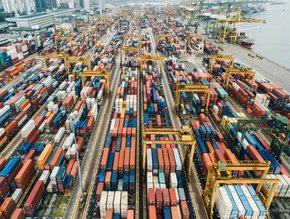A guide to understanding procurement transformation

Procurement transformation refers to the process of implementing changes and improvements to the way an organisation procures goods and services. This can involve a range of activities, including improving the efficiency of the procurement process, reducing costs, increasing transparency, and enhancing the quality of goods and services obtained.
What is procurement transformation?
There are several drivers that can motivate organisations to undergo procurement transformation. These can include the need to reduce costs, improve efficiency and effectiveness, increase transparency and compliance, and enhance the organisation's overall performance.
In a world where supply chains have been heavily impacted by the pandemic, with the situation further exacerbated by the war in Ukraine, procurement transformation is now seen as a necessity for companies to survive, compete and thrive.
To successfully implement procurement transformation, organisations must first assess their current procurement processes and identify areas where improvements can be made. This may involve conducting a thorough analysis of the organisation's procurement activities, including identifying any bottlenecks or inefficiencies in the process.
Once the areas for improvement have been identified, organisations can begin to implement changes to their procurement processes. This may involve adopting new technologies or processes, such as implementing electronic procurement systems or automating certain parts of their operations. It may also involve training staff on new processes and systems, or reorganising the procurement team to better align with the organisation's goals.
Effective procurement transformation requires a clear vision and a well-planned strategy. It also requires the active engagement and support of all stakeholders, including management, employees, and suppliers. By implementing changes and improvements to their procurement processes, organisations can create significant value and enhance their overall performance.
How procurement transformation can create value for your organisation
There are many ways that procurement transformation can create value for organisations. Some of the potential benefits of this process include:
1. Cost Reduction
By streamlining procurement processes and identifying new ways to reduce costs, organisations can save money on the goods and services they purchase. This can be especially important for organisations that operate on tight budgets or are looking to improve their bottom line.
2. Improved Efficiency
Procurement transformation can also improve the efficiency of an organisation's procurement process. By automating certain tasks, introducing new technologies and streamlining processes, organisations can reduce the time and effort required to purchase goods and services.
3. Enhanced Quality
Procurement transformation can also help organisations to improve the quality of the goods and services they obtain. By identifying new suppliers or implementing more rigorous quality standards, organisations can ensure that they are getting the best value for their money.
4. Increased Transparency
Procurement transformation can also increase transparency within an organisation's procurement process. By introducing new technologies or processes that make it easier to track and monitor procurement activities, organisations can increase transparency and reduce the risk of corruption or fraud.
5. Improved Stakeholder Relations
Procurement transformation can also improve relationships with suppliers and other stakeholders. By adopting more ethical and sustainable procurement practices, organisations can build stronger relationships with suppliers and demonstrate their commitment to social and environmental responsibility.
What procurement transformation looks like
Procurement transformation can involve a range of activities and initiatives that are designed to improve the way an organisation procures goods and services. Some examples of these activities might include:
1. Implementing electronic procurement systems
By replacing manual, paper-based procurement processes with electronic systems, organisations can reduce the time and effort required to purchase goods and services. Electronic systems can also make it easier to track and monitor procurement activities, which can increase transparency and reduce the risk of fraud or corruption.
2. Adopting new sourcing strategies
Procurement transformation can also involve adopting new sourcing strategies that help organisations to identify new suppliers or negotiate better prices for goods and services. This might include implementing a total cost of ownership (TCO) analysis to identify the true cost of goods and services, or conducting a supplier analysis to assess the performance of current suppliers.
3. Implementing new processes and procedures
Procurement transformation can also involve introducing new processes and procedures that help to streamline and improve the efficiency of the procurement process. This might include implementing new policies or procedures for approving and tracking purchases, or introducing new tools or technologies to automate certain tasks.
4. Training and development
To successfully implement procurement transformation, it is important to ensure that staff are trained and equipped with the skills and knowledge they need to carry out their duties effectively. This might involve providing training on new technologies or processes, or offering ongoing professional development opportunities to help staff keep up with industry changes.
How to successfully implement procurement transformation
Procurement transformation can be a complex and multifaceted process that requires a thorough understanding of an organisation's procurement activities and the drivers behind them. To successfully implement procurement transformation, organisations must take the following steps:
1. Assess current procurement processes
The first step in procurement transformation is to conduct a thorough analysis of the organisation's current procurement processes. This might involve identifying bottlenecks or inefficiencies in the process, analysing data on procurement activities, and consulting with stakeholders to understand their needs and concerns.
2. Identify areas for improvement
Once the current procurement processes have been assessed, organisations can begin to identify areas where improvements can be made. This might involve identifying opportunities to reduce costs, improve efficiency, or enhance the quality of goods and services obtained.
3. Develop a plan
Once the areas for improvement have been identified, organisations can begin to develop a plan for implementing procurement transformation. This might include setting specific goals and objectives, identifying the resources and support needed to achieve them, and outlining the timeline for implementation.
4. Implement changes
Once the plan has been developed, organisations can begin to implement the changes and improvements needed to transform their procurement processes. This might involve adopting new technologies or processes, training staff on new systems or procedures, and reallocating resources as needed.
5. Monitor and evaluate progress
To ensure that procurement transformation is successful, it is important to monitor and evaluate progress throughout the process. This might involve tracking key performance indicators (KPIs) to measure the effectiveness of the changes, conducting regular reviews to identify any issues or challenges, and making adjustments as needed.
Conclusion
Overall, procurement transformation is a continuous process that requires careful planning and execution to be successful. By implementing changes and improvements to their procurement processes, organisations can create significant value and enhance their overall performance.






